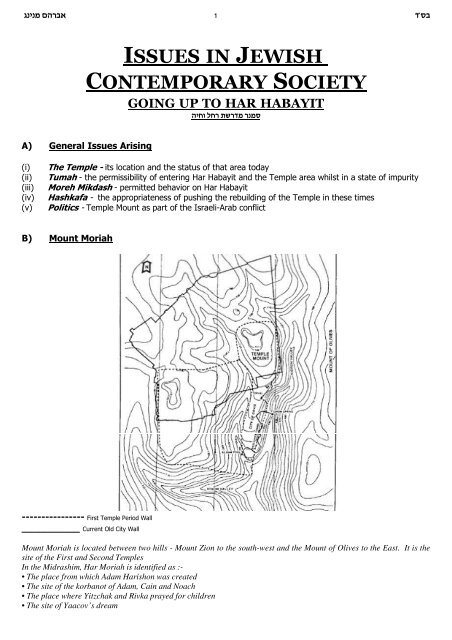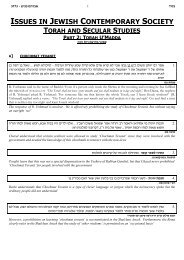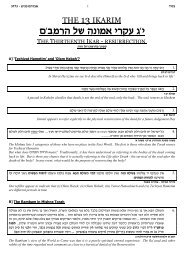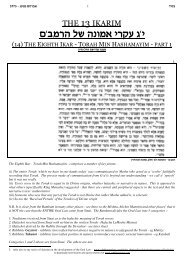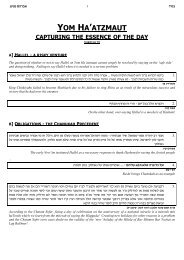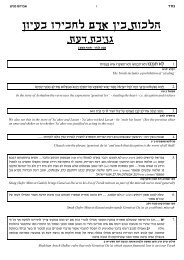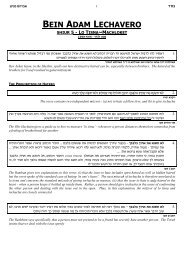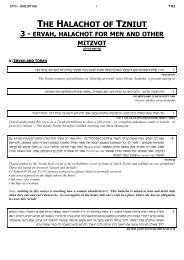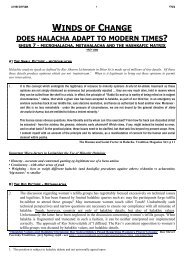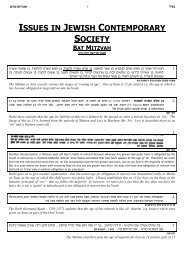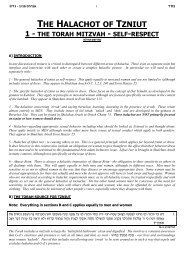Going Up To Har Habayit - Rabbi Anthony Manning
Going Up To Har Habayit - Rabbi Anthony Manning
Going Up To Har Habayit - Rabbi Anthony Manning
You also want an ePaper? Increase the reach of your titles
YUMPU automatically turns print PDFs into web optimized ePapers that Google loves.
dbhbn ovrct<br />
1<br />
ISSUES IN JEWISH<br />
CONTEMPORARY SOCIETY<br />
GOING UP TO HAR HABAYIT<br />
vhju kjr ,arsn rbnx<br />
A) General Issues Arising<br />
(i) The Temple - its location and the status of that area today<br />
(ii) Tumah - the permissibility of entering <strong>Har</strong> <strong>Habayit</strong> and the Temple area whilst in a state of impurity<br />
(iii) Moreh Mikdash - permitted behavior on <strong>Har</strong> <strong>Habayit</strong><br />
(iv) Hashkafa - the appropriateness of pushing the rebuilding of the Temple in these times<br />
(v) Politics - Temple Mount as part of the Israeli-Arab conflict<br />
B) Mount Moriah<br />
---------------- First Temple Period Wall<br />
__________ Current Old City Wall<br />
Mount Moriah is located between two hills - Mount Zion to the south-west and the Mount of Olives to the East. It is the<br />
site of the First and Second Temples<br />
In the Midrashim, <strong>Har</strong> Moriah is identified as :-<br />
• The place from which Adam <strong>Har</strong>ishon was created<br />
• The site of the korbanot of Adam, Cain and Noach<br />
• The place where Yitzchak and Rivka prayed for children<br />
• The site of Yaacov’s dream<br />
s�xc
dbhbn ovrct<br />
2<br />
r �n«t r �J�t ohr� �v �v s �j �t k�g v�k«g�k o �J Uv�k�g �v �u v�H r«N � �v . r� �t k �t W�k Q�k �u e �j �m�h , �t �T �c �v �t r �J�t Wsh � �j�h , �t W�b �C , �t t�b j �e r �nt«H�u 1.<br />
:Wh�k �t<br />
c:cf ,hatrc<br />
In the tanach itself, Eretz Hamoriah is first seen as the place that Avraham Avinu carried out the Akeida<br />
:�v o¬�J �C r�C S � r¬�J�t sº�D�r �c s� �C Æsh �u �S k�g³�H�u yh :h ��x�c�h �v i¬� br� �t ir«d � �C �v��k Æ�j¸�C�z �n oh e³� �v�k shÀ�u �s v´�k�g��h h´�F sh·�u �s�k r«ńt�k s�D�k �t r¬�n �t �v Q¯�t�k �nU jh 2.<br />
Æt�m�H�u shº�u �s�, �t t�r´�H�u Æi�b r� �t y³�C�H�u i·� br� �t�s �g sh�u �s t«¬c�H�u tf :oh ��Y �j J¬�S i� br� �t �u oh·�t �C �j �, �n I N �g uh²�b�C ,�g¯�C r� �t �u Q º�t�k �N �v�, �t Ætr�H�u � iÀ�b r� �t c�J´�H�u f<br />
r¬�m�g��, �u h �k º Uv´�b �T Æt�k �n ; �x³�f �C �v��k �j�C�z �n I¬C�v�b �c �t �u ir«ºD � �v oIé �n Æh�K�v�b �T iÀ�b r� �t�k �t sh¹�u �S r �nt«¸H�u cf :v�m r��t � o�h�P �t sh²�u �s�k Uj¯�T �J�H�u ir«ºD � �v�i �n<br />
oh¬�Y �j��v �u oh²�m�g��k oh¯�D rI � �N �v �u ,I Àk«g��k r ¹�e�C �v h �T¸�,�b Áv �t r � uh·�bh�g �C cI ´Y �v Q�k�N �v h¬�b«s�t G�g²�h �u Q �k�j º ��e Æsh �u �S�k �t i³� br� �t r �nt«¸H�u df :o��g �v k¬� g �n v�p�D �N �v<br />
sh��u �S i��T�H�u vf :o��B �j v�kIg ,I¬k�g��v �u �v�k ÆW�k�r �J�t t³�¬ �t�t� «k hF � t·�k �n ; �x´�f �C v�b �e �t v«¬b �e�h��F t¾ «k iº�b r� �t�k Æsh �u �S Q�k³�N �v r �nt«¸H�u sf :h �T��,�b k«¬F �v v�j�b �N�k<br />
k� g o�h º�n �� �v�i �n ÆJ �t�c Uv³�b�g��H�u �v�k �t Ætr� �e�H�u oh·�n�k �JU ,Ik«g k�g¬�H�u �v��k Æ�j¸�C�z �n sh³�u �S o¸�J Ái�c�H�u uf : ,I �t �n J��J ke�� �J �n c º�v�z h��k �e �J oI ·e �N�C i�� b �r �t�k<br />
�v i´�F �J �nU yf :o��J j�C�z�H�u h·�xUc�h �v i´� br� �t ir«d � �C �v Uv´�b�g�h��F Æsh �u �S ,I ³t r� �C th º�v �v ,´� g�C jf :V��b �s�b�k �t I C r� �j c �J¬�H�u Q º�t�k �N�k �v r �nt«³H�u zf :v��k«g��v j¬�C�z �n<br />
Q¬�t�k �n c�r�j h¾�b �P �n , º�g �c�b h´�F oh·�v«k�t J «r´ s�k � uh�b�p�k ,�f¬�k�k sh²�u �S k«¬f�h�t� «k �u k :iI �g �c�d �C v�n�C �C th·�v �v ,´� g�C v�kIg��v j¬�C�z �nU r²�C s� �N �c v¯�J«n v¸�G�g�r �J�t<br />
:k��t r� �G�h�k v�k«g�k �j¬�C�z �N�v�z �u oh·�v«k�t��v �v ,h�C tU ºv v´�z shº�u �S r �nt«´H�u t cf erp :�v<br />
t:cf-jh:tf �t ohnhv hrcs<br />
David Hamelech was directed by nevuah to establish an altar on the threshing floor of Ornan in Jerusalem. He does<br />
and buys the property from Ornan for a full price. This is a clear parallel to the purchase of Ma’arat Hamachpelah by<br />
Avraham<br />
h �xUc�h �v i�b r� �t ir«d � �C sh �u �S oIe �n �C ih �f �v r �J�t Uvh �c �t sh �u �s�k v �t r�b � r �J�t v�H rIN � �v r �v �C o��k �JUrh �C �v ,h�C , �t ,Ib �c�k v«n«k �J k �j�H�u 3.<br />
t:d �c ohnhv hrcs<br />
Shlomo Hamelech then builds the Temple on this site which is <strong>Har</strong> Hamoriah<br />
,unut ihta ,unuen vakan sjt vz iunhx rc isuh r"t 'vyhae vtnc wudu ukvt oa vyb rat vsav ,ekj ,t iehu 4.<br />
,rgn ';xuh ka u,ruceu 'asenv ,hcu 'vkpfnv ,rgn 'iv uktu ofshc iv ohkuzd rnuk ktrah ,t ,ubuvk ihkufh okugv<br />
sus i,hu (tf t ohnhv hrcs) ch,fs asenv ,hc /iurpgk ovrct kueahu iurpg kt ovrct gnahu (df ,hatrc) ch,fs 'vkpfnv<br />
ofa vbe cegh 'vsav<br />
,ekj ,t iehu (dk ,hatrc) ;xuh ka u,ruceu 'wudu ouenc ibrtk<br />
z:yg varp vcr ,hatrc<br />
The Medrash connects three places in Eretz Yisrael which our forefathers bought for a very high price - Avraham bought<br />
the Cave of Machpela in Chevron, Ya’acov bought the burial plot of Yosef in Shechem and David bought the site of the<br />
Beit Hamikdash. In these three places at least, say Chazal, the other nations of the world have no legitimate grounds to<br />
dispute our ownership. (Ironically, they are today among the most hotly disputed areas)<br />
C) Historical Context<br />
70 CE Temple destroyed by the Romans<br />
100s Some sacrifices still brought in the Temple ruins?<br />
135 Hadrian renames Jerusalem Aelia Capitolina; Temple Mount used for pagan worship<br />
325 Council of Nicea. Constanine builds churches in J-m. Temple Mount abandoned as an icon<br />
333 The ‘Bordeaux Pilgrim’ account of Temple Mount<br />
360 Emperor Julian orders the rebuilding of the Temple, soon abandoned<br />
589 Earthquake in Jerusalem. Byzantine Emperor Valentine calls Jews to rebuild on Temple Mount<br />
614 Persian invade Jerusalem; some clearance of Temple Mount begins<br />
631 Byzantines reinvade Jerusalem<br />
638 Arabs invade Jerusalem<br />
687-691 Dome of Rock constructed<br />
1050 Accounts of a synagaogue on Temple Mount<br />
1099 Jerusalem invaded by the Crusaders. Dome of the Rock became a Church - Templum Domini<br />
1165 Rambam visits Jerusalem (and Temple Mount?)<br />
1187 Jerusalem recaptured by the Moslems. Dome of the Rock restored to Islamic worship<br />
1250 Mamluks take over Jerusalem<br />
1200s Non-Moslems barred from Temple Mount<br />
1517 Ottomans take over Jerusalem<br />
1862 Edward Prince of Wales first non-Moslem allowed onto Temple Mount for centuries<br />
1917 British capture Jerusalem<br />
1948 Jordanians capture Jerusalem<br />
1967 Israelis capture Jerusalem. Jewish access to Temple Mount restored<br />
s�xc
dbhbn ovrct<br />
D) The Structure of the Temple<br />
3<br />
s�xc
dbhbn ovrct<br />
E) The Halachot of Purity and Impurity in the Temple<br />
4<br />
thv ohgkev lu, 'i,hhbj ,gac oa uhv ,ubjn aka - h"ar)<br />
:J �p�b�k t �n �y k«f �u c�z k�f �u �gUr�m k�F v�b�j �N �v i �n Uj�K �Jh �u k �t r� �G�h h�b �C , �t u�m 5.<br />
r,un czv 'ikufk .uj jk,ab gurmv /ktrah vbjn thv ,ujurv gcrt kfk ohkdsv vbjn ;ux sgu oanu ////// chcx ohukv ,hhbj 'vbhfa vbjn<br />
(vbhfa kan tkt jkuan ubhtu vhuk kac ;t r,un apbk tnyu 'oh,av in jkuanu ktrah vbjnc<br />
c:v rcsnc<br />
ihta vn ojkv h,au ohrufcvu rnugv vbnn ohthcna v,ause thv vnu ,umrtv kfn ,asuen ktrah .rt [1] //// (u) 6.<br />
ifu,k ihccxnu ohgrumnv ,t ifu,n ohjkana vbnn ,uasuen vnuj ,upeunv ,urhhg [2] (z) :,umrtv kfn if ohthcn<br />
rv [4] /hba ragnu ohke ohase oa ohkfuta ovn asuen vnujv in ohbpk [3] (j) :u,ut ihrhzjn iht tmh umrha sg ,n<br />
,n tnyu ohcfuf hscug ihta ubnn asuen khjv [5] /oak ohxbfb ,uskuhu ,usb ,uczu ohcz ihta ubnn asuen ,hcv<br />
,asuen ktrah ,rzg [7] /,tyj vhkg ihchhj ihtu oak xbfb ouh kucy ihta ubnn ,asuen ohab ,rzg [6] /oak ohxbfb<br />
oak ohxbfb ktrah ihta vbnn ,asuen ohbvfv ,rzg [8] /,tyj vhkg ihchhju oak xbfb ohrupf rxujn ihta vbnn<br />
atr hgurpu ihnun hkgc ihta vbnn asuen jcznku okutv ihc [9] (y) :vpub,k vyhjak vfhnxk ovhfrm ,gac tkt<br />
ihta ovn asuen ohasev ase [11] /ohkdru ohsh .ujr tka oak xbfb ihta ubnn asuen kfhvv [10] /oak ohxbfb<br />
vsucgv ,gac ohrupfv ouhc kusd ivf tkt oak xbfb<br />
y-u:t ohkf vban<br />
The Mishna lists 11 levels of increasing kedusha (i) Eretz Yisrael; (ii) walled cities in EY ; (iii) Jerusalem within the city<br />
walls; (iv) <strong>Har</strong> <strong>Habayit</strong> from which Zavim, Zavot, Niddot and Yoldot are excluded; (v) inside the ‘Chail’ from which<br />
non-Jews and Tamei Met are excluded; (vi) the Ezrat Nashim from which a ‘Tvul Yom’ is excluded; (vii) the Ezrat Yisrael<br />
from which a ‘Mechusar Kapparah’ is excluded; (viii) the Ezrat Kohanim from which all but the Kohanim are usually<br />
excluded; (ix) between the Altar and the Ulam into which only certain Kohanim may enter; (x) the Heichal into which all<br />
Kohanim entering must have washed their hands and feet; (xi) the Kodesh Kedoshim into which only the Kohen Gadol<br />
was allowed on Yom Kippur (see later for a definition of what the excluded categories comprise)<br />
s�xc<br />
tny asenk tcvu ///////// vru,c ,u,hrf aau ohaka 7.<br />
t vban t erp ,u,hrf ,fxn vban<br />
Entering the Mikdash tameh is one of the 36 prohibition for which one is chiav karet<br />
,rf chhj oak xbfba tnyu 'oak xbfb ohrupf rxujn ihta ohab ,rzgn ,asuen ktrah ,rzg 8.<br />
jh vfkv z erp vrhjcv ,hc ,ufkv o"cnr<br />
The punishment of Karet is applicable for anyone tameh who enters the area of the Ezrat Yisrael or further in<br />
vhukv vbjnc ung ung ;xuh ,unmg ,t van jehu rntba ,hcv rvk xbfvk r,un unmg ,nv ukhpt ,n tny 9.<br />
s vfkv d erp asenv ,thc ,ufkv o"cnr<br />
Someone who is tamei met is permitted to enter to the eternal parts of <strong>Har</strong> <strong>Habayit</strong> (which parallel the Machaneh Leviah)<br />
F) Where was the Temple<br />
crgnv in uyughn iupmv in uk hahka jrznv in uk hba oursv in ucur vnt ,utn anj kg vnt ,utn anj vhv ,hcv rv 10.<br />
t vban c erp ,ushn vban<br />
The Mishna is explicit that <strong>Har</strong> <strong>Habayit</strong> was 500 x 500 amot. There are various opinions on the size on an ama. These<br />
will gives us an area for <strong>Har</strong> <strong>Habayit</strong> of between approximately 220 x 220 m (48,400m 2 ) and 300 x 300 m (90,000 m 2 ).<br />
11. This hill it was which Solomon, who was the first of our kings,by Divine revelation, encompassed with a wall; it<br />
was of excellent workmanship upwards, and round the top of it… This hill was walled all round, and in compass<br />
four stadia (about 185 meters or 607 feet), [the distance of] each angle containing in length a stadia…<br />
Josephus Antiquities 15:11
dbhbn ovrct<br />
5<br />
<strong>To</strong>day the Temple Mount is a rectangular trapezoid NOT a square, and its area is approx 300 x 500 m (150,000 m 2 ).<br />
This means that the Temple Mount is at least 66% bigger than the halachic <strong>Har</strong> <strong>Habayit</strong> an possibly more than 3 times<br />
the size. The actual dimensions of the Temple Mount are 281 metres at the south, 310 metres at the north, 461 metres at<br />
the east and 491 metres at the west.<br />
This is not a surprise as it is well known that Herod increased the Temple area. This means that a large part of what is<br />
now the Temple Mount may be entered without halachic concern. The problem is to identify which part.<br />
s�xc
dbhbn ovrct<br />
6<br />
Temple Mount as it looks today<br />
s�xc
dbhbn ovrct<br />
7<br />
There are 4 main theories based on archeological, documentary and surveying evidence as to where the Temple was<br />
located on the modern Temple Mount<br />
(A) The Central System - that the Rock in the Dome of the Rock 1 is in the position of the Mizbeach (Rav Goren)<br />
This would place the approximate position of <strong>Har</strong><br />
<strong>Habayit</strong> as follows:-<br />
(B) The Middle System - that the Rock in the Dome of the Rock is in the position of the Holy of Holies (Radvaz)<br />
1. The Al-Sakara Rock, roughly 13 meters by 17 meters (43 feet by 56 feet).<br />
+<br />
This would place the approximate position of<br />
<strong>Har</strong> <strong>Habayit</strong> as follows:-<br />
s�xc
dbhbn ovrct<br />
(C) The Northern System - that the Temple lays to the North of the Dome of the Rock<br />
8<br />
This would place the approximate position of<br />
<strong>Har</strong> <strong>Habayit</strong> as follows:-<br />
(D) The Southern System - that the Temple lays to the South of the Dome of the Rock<br />
This would place the approximate position of<br />
<strong>Har</strong> <strong>Habayit</strong> as follows:-<br />
The theory most accepted is the Middle Theory which places the Holy of Holies in the exact place of the Dome of the<br />
Rock. Thus a route around <strong>Har</strong> <strong>Habayit</strong> has been devised to avoid all of the potentially problematic areas where the<br />
Temple complex could have stood (according to current theories)<br />
s�xc
dbhbn ovrct<br />
9<br />
s�xc
dbhbn ovrct<br />
10<br />
This view follows the ‘Route of the Radvaz’ and understands that the Azarah is entirely located on the central, raised<br />
platform on which the Dome of the Rock is sitting . The Cheil around the Azarah is also on the platform. The Ezrat<br />
Nashim is to the east of the platform. They therefore recommend that Jews who go on the east stay close to the eastern<br />
wall of the Temple Mount.<br />
s�xc<br />
Another more<br />
conservative route<br />
around the edge of the<br />
walls of Temple Mount
dbhbn ovrct<br />
G) Is the Temple area still holy?<br />
11<br />
ohbez sjtu ohgca ka ihrsvbx hp kgu ohnu,u ohrutcu thcb p"gu lknv hp kg tkt ,urzgv kg ut rhgv kg ihphxun iht 12.<br />
/vhv lkn ubhcr vanu ',urusk<br />
uag, ifu l,ut vtrn hbt rat kff rntba<br />
th vfkv u erp vrhjcv ,hc ,ufkv o"cnr<br />
The kedusha of the Temple can only be created in the presence of a King, a prophet, a Sanhedrin of 71 <strong>Rabbi</strong>s and the<br />
Urim veTumim which were part of the Cohen Gadol’s clothing. If so, how did Ezra inaugurate the Second Temple when<br />
he was missing the King and the Urim veTumim?<br />
vrzgcu .ujcn ohbuc kfhvca tkt ,urzgk ohgkeu kfhvk ohgke ohaug kfhvc ohbuc uhvaf h,gna rzghkt hcr rnt<br />
ohase ohgke ihta hp kg ;t ohase hase ohkfutu ,hc ihta hp kg ;t ihchrena h,gna gauvh hcr rnt ohbpcn ohbuc<br />
tck sh,gk vaseu v,gak vase vbuatr vausea vnuj ihta hp kg ;t hba ragnu ohke<br />
s�xc<br />
13.<br />
u vban j erp ,uhusg ,fxn vban<br />
uhagnc tk vaga tuv iurfz ,usu, h,a trzg vaga vzu rund ause iht vzv rsxfu ukt kfc vagb tka ouen kf<br />
ashe tuva vnka vasea vbuatr vausec vase,b vncu 'ohnu,u ohrut tku lkn tk oa vhv tka ouenv ase,b<br />
tku uz thv unmg ,rcx t"t /vnka vasea vbuatr vausec :s"ctrv ,dav /tck sh,gk iasheu i,gak ohkaurhu vrzgv<br />
hbta tkt sug tku h"t rtak ohkaurhk asen ihc ekj tk tck sh,gk vase tk vbuatr vause s"nk tnkt //// uk ihtn h,gsh<br />
vhva hpk rnt tk asenku ohkaurhk kct h"t rtak tkt rnt tk tck sh,gk vase vhhba vause rnts hxuh hcrk ukhpta rnut<br />
lfhpk uhtrhk wv suxn hk vkdb lf okugk h"h sucfc hnkug rjt aushe ase,vku ,ub,avk ohsh,g ohkaurhu asenva trzg gsuh<br />
,rf uc iht oa v,g xbfbv<br />
sh vfkv u erp vrhjcv ,hc ,ufkv o"cnr<br />
The position of the Rambam (12C) is that Shlomo Hamelech invested the Temple with a kedusha which was never<br />
nullified, even after the Temple was destroyed. Thus, when Ezra came to build the Second Temple it did not matter that<br />
he had no King or Urim veTumim to create new kedusha - the kedusha was already there and remains to this day. The<br />
Ravad (12C) disagrees and clearly states that there is NO punishment of karet to go onto <strong>Har</strong> HaBayit today. Does this<br />
means that he holds that it is permitted, or just not punishable with karet? 2<br />
xbfvk r,una ouenk tkt xbfh tk 'ubhhbcc uc dvub vhva unf utrunc ost chhj ubh,ubugc crj ouhv asenva p"gt 15.<br />
,ca ,rhna vn 'utrh,<br />
hasenu uruna, h,u,ca ,t rntba jrznv rga sdbf uatr keh tku vrzgc cah tku oak<br />
snug u,ausec crja p"gta okugk asen trun ;t okugk<br />
z vfkv z erp vrhjcv ,hc ,ufkv o"cnr<br />
hn ubhtr tku ubgna tku ukf ,hcv ,t oan ,utrk ,uhkg o,utc ,ukgk okugv kf udvba dvbnk ogy ,,k hk ah n"nu 16.<br />
,hc ,ufkvn haa erp vdavc tmn, ifu asenk xbfba hnk ,rf iht tbshtv hf rcux k"z s"ctrv hf gs /oshc vjhna<br />
//// tk ut asec ,uhubc ov ukt ,uhkg tna epx rcsvu ,eukjn tuv ihsv rehga hrv vrhjcv<br />
tmr, inhx c ekj z"csr ,"ua<br />
The Radvaz (R. David ben Zimra - 16C) writes in a responsum that many people in his time used to go up to view the<br />
Temple area from balconies overhanging Temple Mount. He justifies this practice by applying a double safek - sfeik<br />
sfeika - (i) it was questionable if these balconies were overhanging the actual <strong>Har</strong> <strong>Habayit</strong> area and (ii) the view of the<br />
Ravad was that there is no karet today. However the Radvaz also adds a number of other doubts into the equations to<br />
come up with a heter and it is still not clear that he understands the Ravad’s view to be that that it is permitted to go onto<br />
<strong>Har</strong> <strong>Habayit</strong> today. More recent authorities have understood the Ravad’s opinion to be stricter in practice and not to<br />
allow access to <strong>Har</strong> <strong>Habayit</strong> (see Shu’t Binyan Tzion 1:2)<br />
2. See Mishpat Cohen 96:6 of Rav Kook, who argues that the prohibition (even min ha<strong>To</strong>rah) remains althought the issue karet is<br />
lifted<br />
14.
dbhbn ovrct<br />
12<br />
ubgnaa unf oa xbfhvk yuap dvbnvu 17.<br />
:uy ,ugucak hrhtnv �p<br />
The Meiri (Provence 14C) writes that it was clearly the minhag in his time to allow entry onto the Temple Mount. Some<br />
recent poskim have questioned whether this wording is accurate and whether it can be relied upon<br />
There is a question as to whether the Rambam himself went onto <strong>Har</strong> <strong>Habayit</strong>. His words are recorded as follows:-<br />
kusdv ,hck h,xbfbu vbfx ,j, ohkaurhk ufgn ubtmh vrhmhk u"f ,ba iuajrn jrhk ohnh vgcrt ',cac hahkav ouhu� 18.<br />
"iuajrn jrhk ohnh vanj ouhc uc h,kkp,vu ausevu<br />
dp vcua, ,umn ohsrj rpx<br />
It is not clear where Rambam went that he describes as ‘The Great and Holy House’. It seems likely that this was a part<br />
of <strong>Har</strong> <strong>Habayit</strong> which is permissible to ascend - see source 9<br />
Non-Moslems were banned by the Mamluk and Ottoman authorities from ascending Temple Mount from around the 14C<br />
until 1862 when the first exception was made for the British Edward Prince of Wales (later Edward VII). As such, entry<br />
onto the Temple are was not again discussed practically until the end of the the 19C.<br />
sh,gk vaseu v,gak vase vbuatrv vauseu oh,n htny ubkufa ,rf chhj asen ouenk v,g xbfbvu asenv ,hc 19.<br />
(ovrct idn) tuck<br />
v e"x txe, inhx vrurc vban<br />
The Mishna Berura rules in accordance with the Magen Avraham who follows the Rambam’s view that there is still karet<br />
for a tameh person to go to the Temple area and entering any part of <strong>Har</strong> Bayit is prohibited<br />
H) Ritual Impurity and <strong>Har</strong> <strong>Habayit</strong> <strong>To</strong>day<br />
rnuk lhrm ihtu ,hcv rvk unmg ,nv xhbfvk r,unu 'oak ihxbfb ,uskuhu ,usb ,uczu ihcz ihta vbnn asuen ,hcv rv 20.<br />
oak xbfb tuva ,n tny<br />
uy vfkv z erp vrhjcv ,hc ,ufkv o"cnr<br />
Following the opinion of the Rambam that the kedusha of <strong>Har</strong> <strong>Habayit</strong> applies today, those excluded min ha<strong>To</strong>rah from<br />
anywhere on <strong>Har</strong> <strong>Habayit</strong> are a Zav, Zava, Niddah and Yoledet. Someone who is Tameh Met is allowed onto <strong>Har</strong><br />
<strong>Habayit</strong>, just not into the Temple area itself<br />
vtrb lt /// czv unf ,ubjn �ck .uj jk,aa tuva hre kgc if od urhfzv tk vnk h,gsh tk lt /ohkfs vne erpc vz ihs 21.<br />
hrhhn hre kgcc h,hhnd treu /// vag, tkc rcug xbfb ot ,hcv rvn jkuanv tnyv oa c,f hrva ,nt ihs ihsva<br />
oa lknk vban<br />
Additionally, a Ba’al Keri is prohibited min ha<strong>To</strong>rah from entering <strong>Har</strong> <strong>Habayit</strong>. Furthermore, some understand Rashi’s<br />
opinion to be that a Tevul Yom is assur miderabbanan from anywhere on <strong>Har</strong> <strong>Habayit</strong><br />
Who is excluded from <strong>Har</strong> <strong>Habayit</strong><br />
Zav a man who has experienced a running genital discharge, sometimes associated with venereal disease<br />
Zava a woman who has experienced menstrual bleeding during the middle 11 days of the monthly cycle (when<br />
bleeding is not expected)<br />
Nidda a women who has experienced menstrual bleeding during the beginning of the monthly cycle (when<br />
bleeding is expected)<br />
Yoledet a woman within 7 days of childbirth of a boy and 14 days of a girl<br />
Ba’al Keri a man who has emitted semen or a woman who has had intercourse in the last 3 days<br />
Tvul Yom any person who has been to the mikveh and awaits sunset on that day<br />
Halachic issues arising out of this:-<br />
• <strong>Going</strong> to the mikveh (according to Rashi before sunset the day before)<br />
• Finding a men’s mikvah which is kosher for a tevilah min ha<strong>To</strong>rah, rather than the minhag of ‘Tevilat Ezra’<br />
• The need for a Ma’ayan and not just a Mikvah for a Zav<br />
• Preparation and supervision in the mikveh - for men and women<br />
-<br />
s�xc
dbhbn ovrct<br />
13<br />
• Halachot of Mikveh: chatzitza, beracha etc<br />
• Married women must separate from their husbands for at least 3 days before this mivkeh (according to Rashi must then<br />
wait until the day after mikveh to go up<br />
• Which men are considered to be a Zav?<br />
• Unmarried women and mikveh - should they go, should they tell anyone they have been; brides before the wedding?<br />
• Non-Jews on Temple Mount - permitted areas, behavior<br />
I) The Modern Psak<br />
Those against<br />
Charedi <strong>Rabbi</strong>s have always and still today totally prohibit entry <strong>Har</strong><strong>Habayit</strong>. The position of of the Zionist<br />
establishment is somewhat less clear.In 1967 after the Temple Mount was recaptured the Israeli Chief <strong>Rabbi</strong>nate -<br />
<strong>Rabbi</strong>s Unterman and Nissim put out a statement opposing entry to Temple Mount. The position of Rav Avraham Kook<br />
and Rav Tzvi Yehuda Kook is not clear. They are generally understood to have opposed entering Tenple Mount but Rav<br />
Eliyahu Ra’anan, grandson of Rav A. I. Kook claims that they permitted entry to certain areas,<br />
From 2000-2003 non-Muslims were prevented by the Israeli authorities from ascending the Temple Mount. In 2005 a<br />
large group of National Religious and other <strong>Rabbi</strong>s put out a statement reiterating the position of the Chief <strong>Rabbi</strong>nate<br />
that entry onto Temple Mount is prohibited. Signatories to that statement include:<br />
<strong>Rabbi</strong> Yona Metzger, Ashkenazi Chief <strong>Rabbi</strong> of Israel (March 2012)<br />
<strong>Rabbi</strong> Shlomo Amar, Sefardi Chief <strong>Rabbi</strong> of Israel<br />
<strong>Rabbi</strong> Ovadia Yosef, spiritual leader of Sefardi Charedi Judaism and former Sefardi Chief <strong>Rabbi</strong> of Israel<br />
<strong>Rabbi</strong> Eliyahu Bakshi-Doron, former Sefardi Chief <strong>Rabbi</strong> of Israel (March 2012)<br />
<strong>Rabbi</strong> Shmuel Rabinowitz, Rav of the Kotel (March 2012)<br />
<strong>Rabbi</strong> Avraham Shapiro z’l, former Ashkenazi Chief <strong>Rabbi</strong> of Israel and then Rosh Yeshiva of Yeshivat Mercaz HaRav<br />
<strong>Rabbi</strong> Shlomo Aviner, Rosh yeshiva of Yeshivat Ateret Cohanim<br />
<strong>Rabbi</strong> Yisrael Meir Lau, former Ashkenazi Chief <strong>Rabbi</strong> of Israel and current Chief <strong>Rabbi</strong> of Tel Aviv<br />
<strong>Rabbi</strong> Yitzchak Weiss, the Minchat Yitzchak<br />
<strong>Rabbi</strong> Eliezer Waldenberg, the Tzitz Eliezer<br />
This is also the position on Rav Avigdor Nevensal (March 2012), Rav of the Old City and Rav Aharon Lichtenstein of<br />
Yeshivat <strong>Har</strong> Etzion<br />
s�xc
dbhbn ovrct<br />
14<br />
Those For<br />
In 2007 a large group of <strong>Rabbi</strong>s ascended <strong>Har</strong> <strong>Habayit</strong>. This has become a regular (in fact daily) occurrence since.<br />
Those who permit entry to (at least certain parts of ) Temple Mount include:<br />
<strong>Rabbi</strong> Shlomo Goren z’l, former Ashkenazi Chief <strong>Rabbi</strong>s of Israel<br />
<strong>Rabbi</strong> Chaim David Halevi z’l, former Chief <strong>Rabbi</strong> of Tel Aviv<br />
<strong>Rabbi</strong> Dov Lior, <strong>Rabbi</strong> of Kiryat Arba<br />
<strong>Rabbi</strong> Yisrael Ariel, Rav of Machon Hamikdash<br />
<strong>Rabbi</strong> She'ar Yashuv Cohen, Chief <strong>Rabbi</strong> of Haifa;<br />
<strong>Rabbi</strong> Yuval Sherlo, Rosh Yeshiva of the hesder yeshiva of Petah Tikva<br />
<strong>Rabbi</strong> Yaacov Meidan, Rosh Yeshiva of Yeshivat <strong>Har</strong> Etzion<br />
<strong>Rabbi</strong> Yisrael Yaakov Fischer z’l , former head of the Edah Charedit<br />
<strong>Rabbi</strong> Mordecai Eliyahu<br />
<strong>Rabbi</strong> Yitzchak Shilat, Maaleh Adumim<br />
<strong>Rabbi</strong> Chaim Druckman, Rav of Yeshivot Bnei Akivah<br />
<strong>Rabbi</strong> Yosef Kapach z’l<br />
<strong>Rabbi</strong> Yechiel Michel Tukuchinsky<br />
<strong>Rabbi</strong> Nachum <strong>Rabbi</strong>novitz, Rosh Yeshivat Bircat Moshe, Ma’alei Adumim<br />
<strong>Rabbi</strong> Moshe Tendler 3<br />
<strong>Rabbi</strong> Moshe Feinstein in a teshuva seems to indicate that some parts of the Tenple Mount are permitted to enter<br />
Other arguments brought to justify going onto <strong>Har</strong> <strong>Habayit</strong> today, even into the Temple area include:-<br />
• The halachic permission to go onto <strong>Har</strong> <strong>Habayit</strong> even when tamei in order to construct and fix it. They argue that this<br />
includes inspection and survey<br />
• The halachic obligation to conquer <strong>Har</strong> <strong>Habayit</strong> - they argue that each assent makes it politically harder for the<br />
Moslems to retain ultimate control<br />
I) Moreh Mikdash<br />
c<br />
thv uz htu /u,trh kg vuma hnn tkt trh v,t asenv in tku 'utrh, hasenu rntba asenv in vtrhk vag ,umn<br />
ubhsxc uk ihrurmv ,ugnc ut uhkdr kga ectc ut u,sbuptc ut uhkdrca kgbnc ut ukenc ,hcv rvk ost xbfh tk u,trh<br />
tmhu uz j,pn xbfha lrs ,hcv rv vagh tku 'u,uxfc ughkcn eur uk inszb ot tkt ,hcv rv kfc eurk ruxta k"m ihtu<br />
ubh,ubugc crj ouhv asenva p"gt //// / vumn rcsk tkt uk xbfh tku '.ujcn upheh tkt lrsv rmek hsf vsdbfa j,pn<br />
z<br />
sdbf uatr keh tku vrzgc cah tku oak xbfvk r,una ouenk tkt xbfh tk 'ubhhbcc uc dvub vhva unf utrunc ost chhj<br />
crja p"gta okugk asen trun ;t okugk ,ca ,rhna vn 'utrh, hasenu uruna, h,u,ca ,t rntba jrznv rga<br />
/snug u,ausec<br />
z erp vrhjcv ,hc ,ufkv o"cnr<br />
There are a number of halachic issues of ‘Moreh Mikdash’ - Reverence for the Temple - involved in going onto <strong>Har</strong><br />
<strong>Habayit</strong> including:-<br />
• not wearing leather shoes - people must go barefoot or in cloth socks or shoes<br />
• not becoming ‘light headed’ - chit chat, small talk etc eating is questionable<br />
• not to carry a wallet which is visible<br />
• not to spit<br />
• men must have their heads properly covered - not all kipot will satisfy this requirement which is min ha<strong>To</strong>rah<br />
Rav Ovadia Yosef also rules that since Moreh Mikdash prevents entering the <strong>Har</strong> <strong>Habayit</strong> other than for a mitzva (eg<br />
bringing a sacrifice), it would be assur to go there today. Others would claim that going up today IS a mitzva (eg<br />
conquering the site, keeping it in Jewish hands etc etc). There is also a debate as to whether the mitzva of Moreh Mikdash<br />
will fall away with the prohibition of tumah according to the Ravad’s view (above) or will exist independantly of it today,<br />
even according to the Ravad<br />
3. See a fascinating video of Rav Tendler on <strong>Har</strong> <strong>Habayit</strong> at http://www.youtube.com/watch?v=cw91yrKuQec<br />
t<br />
s�xc<br />
22.
dbhbn ovrct<br />
J) The Hashkafa Angle<br />
Consider how the halachic aspects of this issue are intertwined with the politics and hashkafa including:-<br />
• should we be pushing the rebuilding of the Temple<br />
• should Temple Mount be in our hands<br />
• how do we keep Jewish control of Temple Mount/Jerusalem<br />
• how does Temple Mount impact upon the Middle East peace process<br />
• should we have a shul on Temple Mount now<br />
• is this part of what it means to be Religious Zionist or is it Messianic<br />
K) Further Reading<br />
15<br />
• Entering the Temple Mount in Halacha and Jewish History, Meyer and Messner, Hakira Journal Vol 10 p 29 -<br />
http://www.hakirah.org/Vol%2010%20Messner.pdf<br />
• Halachic Aspects of Visiting the Temple Mount, Stein, Daniel Journal of Halacha and Contemporary Society XLIV, 79<br />
s�xc


